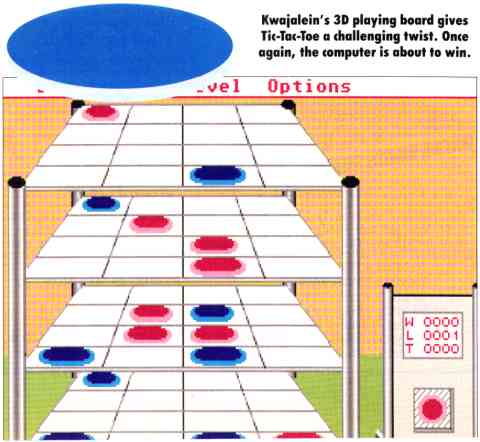New Dimensions In Tic-Tac-Toe
BY MARK ROSS
Not too long ago, I found myself taking a computer class - learning Pascal on a VAX mainframe. One of the assignments was to program a Tic-Tac-Toe game. That made me think of a 3D Tic-Tac-Toe I played on a computer while in high school, so I adapted that idea for my assignment. Later, I couldn't resist the temptation to port my VAX Pascal program to my favorite computer and favorite language: the Atari ST using Laser C. Kwajalein is the result of that effort. With the ST's slick graphics, sound and GEM interface, Kwajalein is a far cry from the old matrix of X's and 0's on a data terminal!
Playing Kwajalein
UnARC the file KWAJARC.PRG by following the instructions in the file
READ_ME. Kwajalein can be run in either high or low resolution. To play
in low resolution, copy the tiles BOARD. PI1, KWAJI.EIN.PRG and TITLESCR.PI1
from your START disk to a play disk. Monochrome users will need BOARD.
P13, KWAJLEIN.PRG and TITLESCR.P13 on their play disk.

To start the game, double-click on KWAJLEIN.PRG, then hit a key or
mouse button after the title screen appears. You will see a playing board
which consists of a 4x4x4 matrix of squares. To the right of the playing
board is a scoreboard and a turn indicator. The scoreboard keeps track
of your wins, losses and ties, and the turn indicator shows a blue disk
(grey in monochrome) when it's your turn to play or a red disk (black in
monochrome) while the computer makes its move.
For the first game, you get to go first. You can claim an unoccupied square by placing the mouse pointer on it, then pressing the left mouse button. You and the computer take turns until the game ends.

The object of the game is the same as regular Tic-Tac-Toe, except you need four in a row instead of three, and you have three dimensions to worry about instead of one. Any straight line of four wins, whether it is up, down, across, or diagonal (corner to corner). It may take you a few games to fully comprehend what constitutes a "straight line" within the perspective-view playing cube! The game ends when one player places four in a row or when all 64 squares are occupied without a winning line (a tic game).

Menu Options
Desk
Choose About to look at the credits. Any desk accessories you
have installed will appear here, too.
File
Quit: Takes you back to the Desktop.
Level
Choose the game's difficulty level here. The default is Amateur.
You should select the Beginner level while you are learning the
game. You may change levels at any time, even during play. Expect the computer
to take a little longer to think at the higher levels. Believe it or not,
even the highest level, Pro, is beatable. After all, what's fun
about playing an invincible opponent?
Options
Show last: Flashes the computer's last move in case you missed
it.
Sound: Toggles the sound effects.
Take back: You may take back as many moves as you like, even after the game is over.
New game: You will have to select this option after each game
if you wish to clear the board and play again. You may also select New
game during play to abort the current game and start over. When you start
a new game keep in mind that the computer gets the first move on alternate
games, so wait for the turn indicator to change to blue (grey in mono)
before attempting to move.
| Program:
Type: Requirements: Arcfile: Files: Language: |
Kwajalein
Game 512K, low or high rez KWAJARC.PRG BOARD.PI1 BOARD.PI3 KWAJLEIN.PRG TITLESCR.PI1 TITLESCR.PI3 Laser C |
Kwajalein?
I chose the game's title from the name of a tiny Pacific island that
I once visited. It is pronounced "quad-ya-line," which makes it kind of
a bad pun on the object of the game! (Quad-your-line, get it?)
Mark Ross hails from Miami Lakes, Fla., where he enjoys the sun and programming in FORTRAN, Pascal and C. This is his first appearance in START